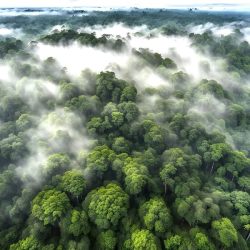Some rainy facts
Here are some interesting and informative rainy facts about the rainforests

Rainforests are some of the most fascinating and biodiverse ecosystems on the planet, and their rainfall patterns are just one of the many unique features that make them so special.
Even though most people are not fond of the rain we will explain with some rainy facts why rain and therefore the rainforests play a crucial role in maintining the quality of life on our planet!

fact 1
The slow descent of raindrops through the dense vegetation of the rainforest not only provides ample time for absorption but also helps to regulate the temperature and humidity levels of the forest. As raindrops fall through the layers of vegetation, they release moisture into the air, which contributes to the high levels of humidity characteristic of the rainforest environment. This high humidity level supports the growth and survival of a wide range of plant and animal species, many of which have adapted to the moist conditions.
Moreover, the dense vegetation of the rainforest canopy and understory also plays an important role in intercepting and storing rainwater, which is crucial for the survival of many forest-dwelling species, including plants and animals. The rainwater that is intercepted and stored by the vegetation is gradually released into the soil and streams, helping to maintain a constant flow of water and nutrients throughout the ecosystem.
In addition to providing a vital source of water and nutrients for the forest, the slow descent of raindrops through the layers of vegetation also helps to reduce soil erosion and sedimentation in the rivers and streams that flow through the rainforest. The intricate system of roots and nutrient cycling that is supported by the absorption of rainwater also helps to maintain the fertility and productivity of the soil, making the rainforest one of the most productive and diverse ecosystems on the planet.

fact 2
In addition to evapotranspiration, the warm and moist conditions of tropical rainforests also contribute to their high levels of rainfall. The constant heat and humidity create the perfect environment for cloud formation and precipitation. Rainforests can receive as much as 400 inches of rainfall per year, with some areas even experiencing up to 600 inches.
The abundance of rainfall is also important for the diverse array of species that call the rainforest home. It allows for the growth of a vast variety of plants, which in turn provide food and habitat for numerous animal species. The rain also plays a role in maintaining the nutrient-rich soil of the rainforest, which is vital to the survival of the plants and animals living there.
However, the delicate balance of the water cycle in the rainforest can be disrupted by climate change and deforestation. Human activities can alter the temperature, humidity, and rainfall patterns, which can have significant impacts on the health and diversity of the rainforest ecosystem.

fact 3
In addition to their role in regulating rainfall patterns, rainforests also play an important role in maintaining water quality. The dense vegetation of rainforests helps to filter and purify water as it moves through the ecosystem, reducing sedimentation and nutrient pollution that can harm downstream ecosystems and human communities.
Moreover, rainforests are also known to influence weather patterns beyond their immediate surroundings. The vast amounts of moisture released through evapotranspiration can form atmospheric rivers, which are long, narrow bands of water vapor that can travel thousands of miles, influencing weather patterns in distant regions.
The importance of rainforests in the global water cycle is also reflected in their role as a source of freshwater. Many of the world’s major rivers, including the Amazon, Congo, and Mekong, have their origins in tropical rainforests. These rivers provide water for millions of people, as well as important irrigation and hydroelectric power generation for agricultural and industrial use.
The role of rainforests in the water cycle extends far beyond their immediate surroundings, making them a critical component of the Earth’s water and climate systems.

fact 4
In addition to their role in the water cycle, rainforests are crucial for storing vast quantities
of freshwater. The high levels of rainfall in these regions are captured by the forest canopy, and the water slowly filters through the soil to recharge underground aquifers, the source of many of the world’s rivers. The Amazon Basin alone stores an estimated 20% of the world’s freshwater, making it one of the most important natural water reserves on the planet.
This water storage capacity has significant implications for the global climate and the health of the planet’s ecosystems. During periods of drought, rainforests can provide a vital source of water to nearby communities, helping to prevent water shortages and maintaining the health of local ecosystems. Additionally, the vast stores of water stored in rainforests can help mitigate the effects of climate change by buffering against fluctuations in rainfall patterns and supporting the health and growth of plants and animals that are dependent on freshwater.

fact 5
Rainforests are crucial to climate regulation as they act as carbon sinks, absorbing and storing significant amounts of carbon dioxide, a greenhouse gas that contributes to climate change. The process of photosynthesis, where plants use sunlight to convert carbon dioxide into organic matter, enables rainforests to absorb and store carbon for extended periods, making them an important natural tool for mitigating climate change. In addition to their carbon sequestration role, rainforests also release oxygen, which is vital for sustaining life on Earth. However, deforestation and land-use change have reduced the capacity of rainforests to absorb and store carbon, thereby contributing to rising atmospheric carbon dioxide levels and exacerbating the climate crisis.
We hope you gained some knowledge with our rainy facts and why it is important to help us protect the Amazon rainforest!

